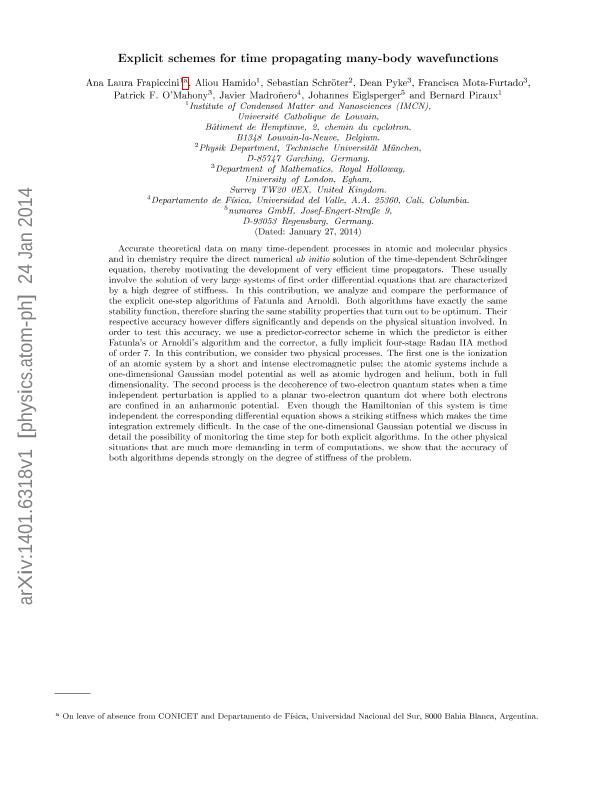Mostrar el registro sencillo del ítem
dc.contributor.author
Frapiccini, Ana Laura

dc.contributor.author
Hamido, Aliou
dc.contributor.author
Schröter, Sebastian
dc.contributor.author
Pyke, Dean
dc.contributor.author
Mota Furtado, Francisca
dc.contributor.author
O’Mahony, Patrick F.
dc.contributor.author
Madroñero, Javier
dc.contributor.author
Eiglsperger, Johannes
dc.contributor.author
Piraux, Bernard
dc.date.available
2020-01-15T19:08:56Z
dc.date.issued
2014-02-14
dc.identifier.citation
Frapiccini, Ana Laura; Hamido, Aliou; Schröter, Sebastian; Pyke, Dean; Mota Furtado, Francisca; et al.; Explicit schemes for time propagating many-body wave functions; American Physical Society; Physical Review A: Atomic, Molecular and Optical Physics; 89; 2; 14-2-2014; 1-15
dc.identifier.issn
1050-2947
dc.identifier.uri
http://hdl.handle.net/11336/94789
dc.description.abstract
Accurate theoretical data on many time-dependent processes in atomic and molecular physics and in chemistry require the direct numerical ab initio solution of the time-dependent Schrödinger equation, thereby motivating the development of very efficient time propagators. These usually involve the solution of very large systems of first-order differential equations that are characterized by a high degree of stiffness. In this contribution, we analyze and compare the performance of the explicit one-step algorithms of Fatunla and Arnoldi. Both algorithms have exactly the same stability function, therefore sharing the same stability properties that turn out to be optimum. Their respective accuracy, however, differs significantly and depends on the physical situation involved. In order to test this accuracy, we use a predictor-corrector scheme in which the predictor is either Fatunla's or Arnoldi's algorithm and the corrector, a fully implicit four-stage Radau IIA method of order 7. In this contribution, we consider two physical processes. The first one is the ionization of an atomic system by a short and intense electromagnetic pulse; the atomic systems include a one-dimensional Gaussian model potential as well as atomic hydrogen and helium, both in full dimensionality. The second process is the decoherence of two-electron quantum states when a time-independent perturbation is applied to a planar two-electron quantum dot where both electrons are confined in an anharmonic potential. Even though the Hamiltonian of this system is time independent the corresponding differential equation shows a striking stiffness which makes the time integration extremely difficult. In the case of the one-dimensional Gaussian potential we discuss in detail the possibility of monitoring the time step for both explicit algorithms. In the other physical situations that are much more demanding in term of computations, we show that the accuracy of both algorithms depends strongly on the degree of stiffness of the problem.
dc.format
application/pdf
dc.language.iso
eng
dc.publisher
American Physical Society

dc.rights
info:eu-repo/semantics/openAccess
dc.rights.uri
https://creativecommons.org/licenses/by/2.5/ar/
dc.subject
TDSE
dc.subject
Explicit propagator
dc.subject
Arnoldi
dc.subject
Runge-Kutta
dc.subject.classification
Física Atómica, Molecular y Química

dc.subject.classification
Ciencias Físicas

dc.subject.classification
CIENCIAS NATURALES Y EXACTAS

dc.title
Explicit schemes for time propagating many-body wave functions
dc.type
info:eu-repo/semantics/article
dc.type
info:ar-repo/semantics/artículo
dc.type
info:eu-repo/semantics/publishedVersion
dc.date.updated
2019-10-04T17:10:36Z
dc.identifier.eissn
1094-1622
dc.journal.volume
89
dc.journal.number
2
dc.journal.pagination
1-15
dc.journal.pais
Estados Unidos

dc.journal.ciudad
Nueva York
dc.description.fil
Fil: Frapiccini, Ana Laura. Université Catholique de Louvain; Bélgica. Consejo Nacional de Investigaciones Científicas y Técnicas. Centro Científico Tecnológico Conicet - Bahía Blanca; Argentina
dc.description.fil
Fil: Hamido, Aliou. Université Catholique de Louvain; Bélgica
dc.description.fil
Fil: Schröter, Sebastian. Technische Universitat München; Alemania
dc.description.fil
Fil: Pyke, Dean. University of London; Reino Unido
dc.description.fil
Fil: Mota-Furtado, Francisca. University of London; Reino Unido
dc.description.fil
Fil: O’Mahony, Patrick F.. University of London; Reino Unido
dc.description.fil
Fil: Madroñero, Javier. Universidad del Valle; Colombia
dc.description.fil
Fil: Eiglsperger, Johannes. Numares GmbH; Alemania
dc.description.fil
Fil: Piraux, Bernard. Université Catholique de Louvain; Bélgica
dc.journal.title
Physical Review A: Atomic, Molecular and Optical Physics

dc.relation.alternativeid
info:eu-repo/semantics/altIdentifier/url/https://journals.aps.org/pra/abstract/10.1103/PhysRevA.89.023418
dc.relation.alternativeid
info:eu-repo/semantics/altIdentifier/doi/http://dx.doi.org/10.1103/PhysRevA.89.023418
dc.relation.alternativeid
info:eu-repo/semantics/altIdentifier/url/https://arxiv.org/abs/1401.6318
Archivos asociados
